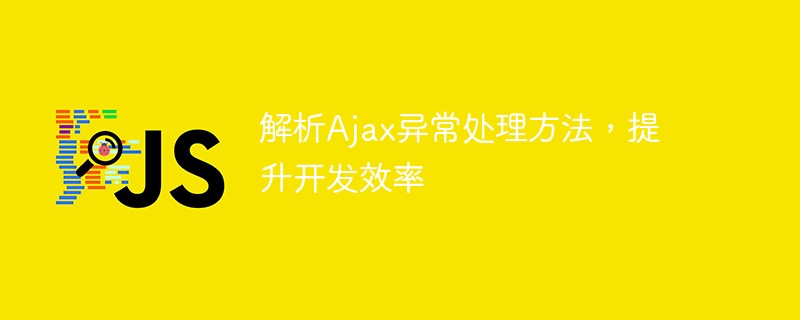Home >Web Front-end >JS Tutorial >Optimize development efficiency and analyze and handle Ajax exceptions
Optimize development efficiency and analyze and handle Ajax exceptions
- 王林Original
- 2024-01-30 08:13:18926browse

Analysis of Ajax exception handling methods to improve development efficiency
In the process of using Ajax for front-end and back-end data interaction, we will inevitably encounter various abnormal situations . Handling these exceptions correctly can not only provide a better user experience, but also improve development efficiency. This article will explain in detail how to handle Ajax exceptions and give corresponding code examples.
1. What is Ajax exception
In Ajax requests, the following types of exceptions may occur:
- Network exception: such as network disconnection or service interruption The terminal did not respond.
- Server error: For example, the requested resource does not exist or the request processing is abnormal.
- Cross-domain problem: Due to the browser's same-origin policy restrictions, Ajax requests cannot cross domains.
- Parameter errors: For example, when submitting a form, the parameters are incomplete or incorrectly formatted.
2. Exception handling methods
We can use different processing methods to improve development efficiency for different exception situations.
- Network exception handling
Network exceptions may be caused by unstable user networks or problems on the server side. In order to provide a better user experience, you can set a timeout when sending an Ajax request. After the set time is exceeded, it will be determined as a network abnormality and the user will be given a corresponding prompt.
Code example:
$.ajax({
url: 'xxx',
timeout: 5000, // 设置超时时间为5秒
success: function(response) {
// 处理响应数据
},
error: function(xhr, status, error) {
if (status === 'timeout') {
// 网络超时处理
} else {
// 其他网络异常处理
}
}
});- Server error handling
When the server response status code is non-200, it can be considered that there is a problem with the request. We Server errors can be handled through the error callback function.
Code sample:
$.ajax({
url: 'xxx',
success: function(response) {
// 处理响应数据
},
error: function(xhr, status, error) {
// 服务器错误处理
}
});- Cross-domain problem handling
When our front-end page and the back-end API interface are not in the same domain, it will Encountering cross-domain issues. In order to solve this problem, we can enable cross-domain access by setting the response header of the backend API interface.
Code sample (back-end PHP code):
header('Access-Control-Allow-Origin: *'); // 允许跨域访问,*代表任意域名
header('Access-Control-Allow-Methods: GET, POST, PUT, DELETE'); // 允许的请求方法
// 其他响应头设置- Parameter error handling
When the form parameters submitted by the front-end are incomplete or incorrectly formatted , we can remind users through verification logic. Basic verification can be performed on the front-end page, or strict verification can be performed on the back-end.
Code sample (front-end JS code):
$('#submitBtn').click(function() {
var username = $('#username').val();
var password = $('#password').val();
if (!username || !password) {
alert('用户名和密码不能为空');
return;
}
// 发送Ajax请求
});3. Summary
When using Ajax for data interaction, correctly handling exceptions can improve development efficiency and user experience. By setting timeouts, handling server errors, handling cross-domain issues, and performing parameter verification, we can better deal with various abnormal situations. I hope the analysis and code examples in this article can help you better handle Ajax exceptions and improve development efficiency.
The above is the detailed content of Optimize development efficiency and analyze and handle Ajax exceptions. For more information, please follow other related articles on the PHP Chinese website!
Related articles
See more- Teach you detailed steps to improve the efficiency of WeChat mini program development
- What are the forms of python exception handling structures?
- Detailed explanation of Python exception handling mechanism
- An article explaining in detail how Vue3 handles global exceptions
- Distinguish between spring containers and ioc containers to improve development efficiency

